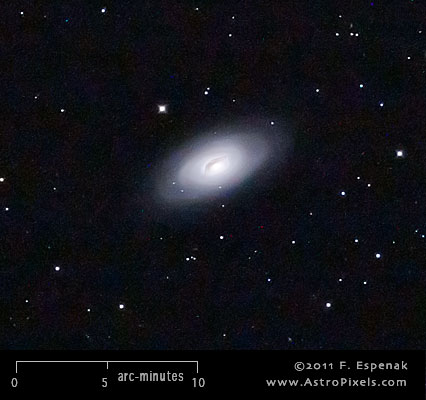
M64 - Black Eye Galaxy
Messier 64 or M64 (also designated NGC 4826) is a spiral galaxy in the constellation Coma Berenices. It has an apparent visual magnitude of 8.5 and its angular diameter is 9.3 x 5.4 arc-minutes. M64 lies at an estimated distance of 19 million light years. The Equinox 2000 coordinates are RA= 12h 56.7m, Dec= +21° 41´ which makes M64 best seen during the spring. The Messier Spring Star Chart shows the position of all Messier objects visible during that season. As one of the more famous objects in the Messier Catalog, it is commonly known as the Black Eye Galaxy.
The image above shows the uncropped view of M64 through the Takahashi E-180 Astrograph (North is up). A 3x enlargement of this image appears to the right.
Although included in the Messier Catalog, this spiral galaxy was actually discovered by N. Pigott in 1779. The Black Eye Galaxy (aka Sleeping Beauty Galaxy) contains a conspicuous lane of dust that obscures the stars behind it. According to Stoyan et al. (2010), the distance of M64 is 18.3 million light years and its diameter is 56,000 light years.
For more information, see the Messier Catalog as well as specific entries for M64 in Wikipedia and SEDS.
Messier's Description of M64
March 1, 1780
`Nebula discovered in Coma Berenices, which is about half as apparent as
that which is below the hair [M53].
M. Messier has reported its position on the Chart of the Comet of 1779.
Reviewed on March 17, 1781.'
Technical Details
- Object: M64
- Other Names: NGC 4826, Black Eye Galaxy
- Object Type: spiral galaxy
- Object Data: Apparent Magnitude = 8.5, Angular Size = 9.3 x 5.4 arc-minutes
- Object Position (Equinox 2000): RA= 12h 56.7m, Dec= +21° 41´, Constellation = Coma Berenices
- Date/Time: 2011 May 07 at 04:39 UTC
- Location: Bifrost Astronomical Observatory, Portal, AZ
- Mount: Astro-Physics 1200GTO
- Telescope: Takahashi Epsilon 180 Hyperbolic Astrograph
- Camera: Canon EOS 550D (Rebel T2i) (modified with a Baader UV/IR filter)
- Field of View: 1.70° x 2.56° at 1.7 arc-sec/pixel (web version: 10.0 arc-sec/pixel)
- Exposure: 4 x 300s, f/2.8, ISO 800
- File Name: M64-01w.jpg
- Processing (Adobe Camera Raw): Graduated Filter, Vignetting Correction, Noise Reduction, White Balance, Curves
- Processing (Photoshop CS5): Average Images, Curves, Noise Reduction
- Original Image Size: 3454 × 5179 pixels (17.9 MP); 11.5" x 17.3" @ 300 dpi
- Rights: Copyright 2011 by Fred Espenak. All Rights Reserved. See: Image Licensing.
